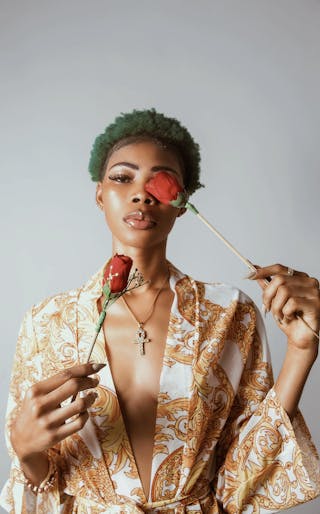Creating An Asexual Character For TV Showed Me We Have A Way To Go
If you're tired of seeing the same old tired stereotypes on TV, you're not alone. It's time for more diverse and accurate representation, and that includes asexual characters. It's time to challenge the status quo and demand better from showrunners and writers. And while you're at it, why not explore the growing local sex scene in Indianapolis? Check it out and see what's happening in your city.
As a writer for a dating blog, I often find myself exploring the various facets of human sexuality and how it is portrayed in popular culture. Recently, I had the opportunity to watch a TV show that featured an asexual character, and it really opened my eyes to the lack of representation and understanding of asexuality in mainstream media.
If you're a farmer looking for love, you should definitely try out this dating site designed specifically for farmers.
The portrayal of asexual characters on TV is often limited and stereotypical, which can be frustrating for those who identify as asexual or are looking for accurate representation. In this article, I will discuss my experience watching a TV show featuring an asexual character and explore the ways in which we still have a long way to go in terms of inclusivity and representation in the media.
If you're looking to spice up your dating life, why not try out the VRConk discount at DatingTales for a unique and immersive experience.
The Lack of Representation
Explore exciting gay dating opportunities in Dallas!
When it comes to representation of asexuality on TV, there is a noticeable lack of diversity and depth. Asexual characters are often portrayed as emotionless or robotic, reinforcing harmful stereotypes and misconceptions about asexuality. This not only perpetuates stigma but also alienates asexual individuals who are seeking validation and understanding.
In the TV show I watched, the asexual character was depicted as socially awkward and uninterested in romantic or sexual relationships. While this may be the experience of some asexual individuals, it is important to recognize that asexuality is a spectrum and can manifest in various ways. By portraying asexual characters in such a limited and one-dimensional way, TV shows are missing the opportunity to educate and enlighten audiences about the diversity of human sexuality.
The Importance of Accurate Representation
Accurate representation of asexuality on TV is crucial for fostering understanding and acceptance within society. By showcasing a range of asexual characters with different personalities, experiences, and relationships, TV shows have the power to challenge stereotypes and promote inclusivity. This can also provide a sense of validation for asexual individuals who often feel marginalized and misunderstood.
In the TV show I watched, the asexual character's storyline revolved around their struggle to find acceptance and understanding from their friends and family. While this is a reality for many asexual individuals, it is important to also highlight the joy, fulfillment, and resilience that can come with navigating relationships and identity as an asexual person. By showcasing a more nuanced and positive portrayal of asexuality, TV shows can contribute to a more inclusive and empathetic society.
The Need for Authentic Storytelling
In order to create more authentic and respectful portrayals of asexuality on TV, it is crucial for writers and creators to engage with asexual communities and individuals. By listening to their stories and experiences, TV shows can ensure that they are representing asexuality in a way that is respectful, accurate, and empowering. This can also help to avoid harmful tropes and stereotypes that perpetuate stigma and misinformation.
In the TV show I watched, it was clear that the creators had made an effort to depict the asexual character with sensitivity and care. However, there were still missed opportunities for more nuanced and authentic storytelling. By consulting with asexual individuals and organizations, TV shows can ensure that they are accurately representing the diverse experiences of asexuality and contributing to a more inclusive media landscape.
Moving Forward
While the portrayal of asexual characters on TV has come a long way, there is still much work to be done in terms of representation and understanding. By creating more diverse, authentic, and respectful portrayals of asexuality, TV shows have the power to challenge stereotypes, promote inclusivity, and foster empathy within society.
As a writer for a dating blog, I hope to see more TV shows taking the initiative to engage with asexual communities and individuals in order to create more accurate and empowering representations of asexuality. By doing so, TV shows can contribute to a more inclusive and understanding society, and provide validation and visibility for asexual individuals who have long been overlooked and marginalized in mainstream media.
- https://sexting.ua-sex.com/posts/12-queer-women-share-their-biggest-dating-red-flags/
- https://online-sex.campsupernow.com/posts/antiracist-dating-how-to-be-anti-racist-on-dates/
- https://find-singles.thehottieandthenottie.com/posts/if-being-bisexual-was-actually-a-choice/
- https://hookup-website.campsupernow.com/posts/threesome-positions-6-best-threesome-sex-positions/
- https://singles.timebombrecordings.com/posts/what-to-wear-to-a-sex-party/
- https://chat.getweps.com/posts/my-best-sex-ever-was-when-i-filmed-myself-masturbating/
- https://find-a-girlfriend.thehottieandthenottie.com/posts/why-you-should-embrace-your-delulu-dating-goals/
- https://matchmaker-website.fu-direct.net/posts/my-best-sex-ever-was-when-i-didnt-come/
- https://meet-singles.campsupernow.com/posts/queer-dating-app-just-launches-thirst-mode-for-pride-month/
- https://hookupsites.getweps.com/posts/multiple-orgasms-6-best-sex-positions-for-climax/
- https://singles-chat.thehottieandthenottie.com/posts/how-to-have-sex-how-to-have-the-best-sex/
- https://matchmaker.timebombrecordings.com/posts/pansexual-meaning-and-definition-what-is-pansexual/
- https://find-a-girlfriend.thehottieandthenottie.com/posts/messaging-and-texting-mistakes-people-make-when-dating/
- https://sex-app.themountaintopplay.com/posts/strapons-best-sex-toys-for-pegging/
